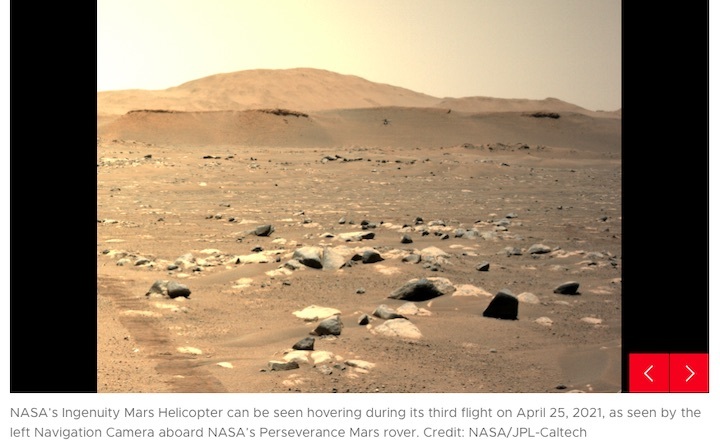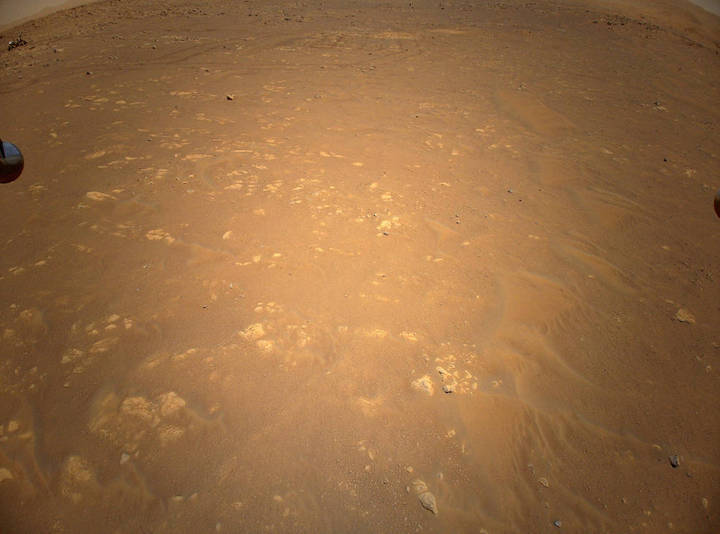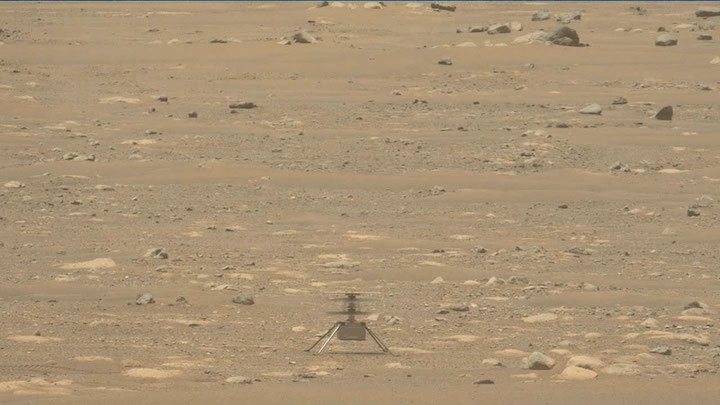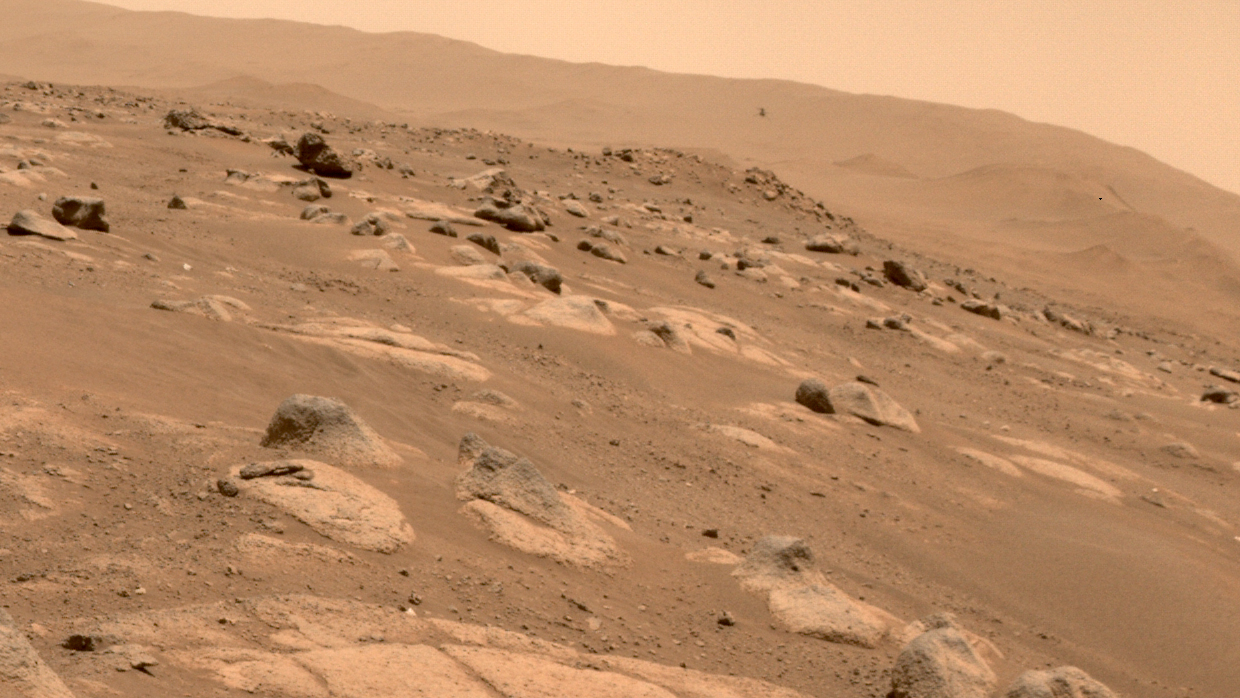Data received from the Mars Ingenuity helicopter on Thursday morning shows the helicopter did not execute its planned fourth flight as scheduled. The helicopter is safe and in good health. Data returned during a downlink at 1:21 p.m. EDT (10:21 a.m. PDT) indicates the helicopter did not transition to flight mode, which is required for the flight to take place.
The team plans to try its fourth flight again tomorrow, April 30, 2021. The flight is scheduled for 10:46 a.m. EDT (7:46 a.m. PDT, 12:30 p.m. local Mars time), with the first data expected back at NASA’s Jet Propulsion Laboratory in Southern California at 1:39 p.m. EDT (10:39 a.m. PDT).
An issue identified earlier this month showed a 15% chance for each time the helicopter attempts to fly that it would encounter a watchdog timer expiration and not transition to flight mode. Today’s delay is in line with that expectation and does not prevent future flights. A briefing scheduled for Friday, April 30, to discuss next steps for the helicopter will continue as planned but will move to a new time, 11:30 a.m. EDT (8:30 a.m. PDT).
Quelle: NASA
+++
NASA Mars helicopter 'Ingenuity' fails to take flight during fourth run, rescheduled to Friday
Mars' atmosphere is incredibly thin, which makes flying a tall task
NASA's helicopter on Mars, the four-pound "Ingenuity," failed to get off the ground for its fourth flight Thursday, but NASA said it is safe and will try again Friday.
Previous test flights for the helicopter went well, with Ingenuity rising up 16 feet in the air during the third flight last Sunday then flashing downrange about 50 yards at a speed of 6.6 feet per second.
The second test flight on April 22 and the first flight on April 19 also went as planned.
The cause of Thursday's hiccup was a "watchdog" timer issue that prevented Ingenuity from transitioning to "flight mode."
Flying on Mars is no easy task, as the atmosphere is incredibly thin, about 1% that of Earth's. Nighttime temperatures on the Red Planet can also drop as low as minus 130 degrees, potentially freezing any unprotected electrical systems.
"Mars is hard," MiMi Aung, project manager for Ingenuity Mars Helicopter, said before the test flights. "Our plan is to work whatever the Red Planet throws at us the very same way we handled every challenge we’ve faced over the past six years – together, with tenacity and a lot of hard work, and a little Ingenuity."
Ingenuity originally touched down at an ancient river delta on Mars in mid-February aboard Perseverance before coming out of the rover's belly on April 3.
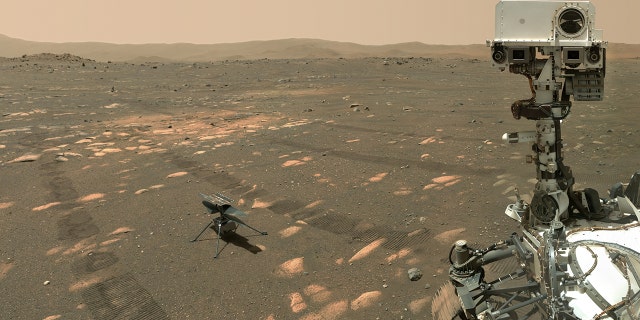
NASA’s Perseverance Mars rover took a selfie with the Ingenuity helicopter, seen here about 13 feet from the rover. This image was taken by the WASTON camera on the rover’s robotic arm on April 6, 2021, the 46th Martian day, or sol, of the mission. (NASA/JPL-Caltech/MSSS)
Once Ingenuity's test flights are completed, the Perseverance rover will set off in search of past microscopic life.
Ingenuity was built at NASA's Jet Propulsion Laboratory in California and is carrying some wing fabric from the Wright Flyer that made the first ever flight on earth at Kitty Hawk, North Carolina in 1903.
Quelle: FOX NEWS
+++
NASA’s Ingenuity Mars Helicopter to Begin New Demonstration Phase
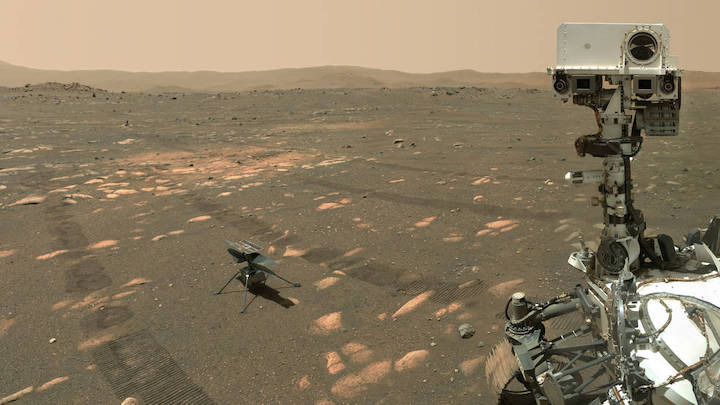
NASA’s Ingenuity Mars Helicopter has a new mission. Having proven that powered, controlled flight is possible on the Red Planet, the Ingenuity experiment will soon embark on a new operations demonstration phase, exploring how aerial scouting and other functions could benefit future exploration of Mars and other worlds.
This new phase will begin after the helicopter completes its next two flights. The decision to add an operations demonstration is a result of the Perseverance rover being ahead of schedule with the thorough checkout of all vehicle systems since its Feb 18 landing, and its science team choosing a nearby patch of crater bed for its first detailed explorations. With the Mars Helicopter’s energy, telecommunications, and in-flight navigation systems performing beyond expectation, an opportunity arose to allow the helicopter to continue exploring its capabilities with an operations demonstration, without significantly impacting rover scheduling.
“The Ingenuity technology demonstration has been a resounding success,” said Thomas Zurbuchen, associate administrator for NASA’s Science Mission Directorate. “Since Ingenuity remains in excellent health, we plan to use it to benefit future aerial platforms while prioritizing and moving forward with the Perseverance rover team’s near-term science goals.”
The operations demonstration will begin in about two weeks with the helicopter’s sixth flight. Until then, Ingenuity will be in a transitional phase that includes its fourth and fifth forays into Mars’ crimson skies. Flight four will send the rotorcraft about 436 feet (133 meters) south to collect aerial imagery of a potential new landing zone before returning to land at Wright Brothers Field, the name for the Martian airfield on which Ingenuity’s first flight took place. This 873-foot (266-meter) roundtrip effort would surpass the range, speed, and duration marks achieved on the third flight. Ingenuity was programmed to execute a fourth flight Friday, with a takeoff to take place at 10:46 a.m. EDT (7:46 a.m. PDT, 12:30 p.m. local Mars time) and first data to be returned at 1:39 p.m. EDT (10:39 a.m. PDT). The fifth flight would send Ingenuity on a one-way mission, landing at the new site. If Ingenuity remains healthy after those flights, the next phase can begin.
Change of Course
Ingenuity’s transition from conducting a technology demonstration to an operations demonstration brings with it a new flight envelope. Along with those one-way flights, there will be more precision maneuvering, greater use of its aerial-observation capabilities, and more risk overall.
The change also means Ingenuity will require less support from the Perseverance rover team, which is looking ahead for targets to take rock and sediment samples in search of ancient microscopic life. On April 26 – the mission’s 66th sol, or Martian day – Perseverance drove 33 feet (10 meters) with the goal to identify targets.
“With the short drive, we have already begun our move south toward a location the science team believes is worthy of investigation and our first sampling,” said Ken Farley, project scientist for the Perseverance rover from Caltech in Pasadena, California. “We’ll spend the next couple of hundred sols executing our first science campaign looking for interesting rock outcrop along this 2-kilometer (1.24-mile) patch of crater floor before likely heading north and then west toward Jezero Crater’s fossil river delta.”
With short drives expected for Perseverance in the near term, Ingenuity may execute flights that land near the rover’s current location or its next anticipated parking spot. The helicopter can use these opportunities to perform aerial observations of rover science targets, potential rover routes, and inaccessible features while also capturing stereo images for digital elevation maps. The lessons learned from these efforts will provide significant benefit to future mission planners. These scouting flights are a bonus and not a requirement for Perseverance to complete its science mission.
The cadence of flights during Ingenuity’s operations demonstration phase will slow from once every few days to about once every two or three weeks, and the forays will be scheduled to avoid interfering with Perseverance’s science operations. The team will assess flight operations after 30 sols and will complete flight operations no later than the end of August. That timing will allow the rover team time to wrap up its planned science activities and prepare for solar conjunction – the period in mid-October when Mars and Earth are on opposite sides of the Sun, blocking communications.
“We have so appreciated the support provided by the Perseverance rover team during our technology demonstration phase,” said MiMi Aung, project manager of Ingenuity at NASA’s Jet Propulsion Laboratory (JPL) in Southern California. “Now we have a chance to pay it forward, demonstrating for future robotic and even crewed missions the benefits of having a partner nearby that can provide a different perspective – one from the sky. We are going to take this opportunity and run with it – and fly with it.”
Quelle: NASA
+++
Perseverance's Hazard Cameras View Ingenuity's Fourth Flight
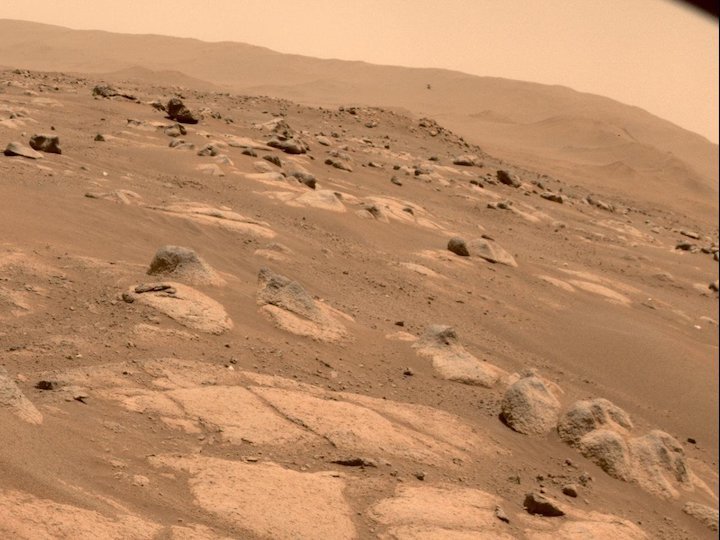
NASA's Ingenuity Mars Helicopter is viewed by one of the hazard cameras aboard the Perseverance rover during the helicopter's fourth flight on April 30, 2021.
The Ingenuity Mars Helicopter was built by JPL, which also manages this technology demonstration project for NASA Headquarters. It is supported by NASA's Science Mission Directorate, Aeronautics Research Mission Directorate, and Space Technology Mission Directorate. NASA's Ames Research Center and Langley Research Center provided significant flight performance analysis and technical assistance during Ingenuity's development. AeroVironment Inc., Qualcomm, Snapdragon, and SolAero also provided design assistance and major vehicle components. The Mars Helicopter Delivery System was designed and manufactured by Lockheed Space Systems in Denver.
More About the Mission
A key objective for Perseverance's mission on Mars is astrobiology, including the search for signs of ancient microbial life. The rover will characterize the planet's geology and past climate, pave the way for human exploration of the Red Planet, and be the first mission to collect and cache Martian rock and regolith (broken rock and dust).
Subsequent NASA missions, in cooperation with ESA (European Space Agency), would send spacecraft to Mars to collect these sealed samples from the surface and return them to Earth for in-depth analysis.
The Mars 2020 Perseverance mission is part of NASA's Moon to Mars exploration approach, which includes Artemis missions to the Moon that will help prepare for human exploration of the Red Planet.
JPL, which is managed for NASA by Caltech in Pasadena, California, built and manages operations of the Perseverance rover.
Quelle: NASA
+++
Ingenuity successfully completed its fourth flight today, and we couldn’t be happier. The helicopter took off at 10:49 a.m. EDT (7:49 a.m. PDT, or 12:33 local Mars time), climbing to an altitude of 16 feet (5 meters) before flying south approximately 436 feet (133 meters) and then back, for an 872-foot (266-meter) round trip. In total, we were in the air for 117 seconds. That’s another set of records for the helicopter, even compared to the spectacular third flight.
We also managed to capture lots of images during the flight with the color camera and with Ingenuity’s black-and-white navigation camera, which tracks surface features as it flies. Images from that navigation camera are typically used by Ingenuity’s flight controller and then thrown away unless we specifically tell the helicopter to store them for later use. During this flight, we saved even more images than we did on our previous flights: about 60 total during the last 164 feet (50 meters) before the helicopter returned to its landing site.

Capturing images like that provides a technical challenge – another way to test Ingenuity – and provides an aerial perspective of Mars that humanity has never seen before. We’ll use these images to study the surface features of the terrain. Some of our black-and-white images were taken as stereo pairs, allowing us to test our ability to make 3D imagery of the surface and study the elevation of different sites below us. Adding this dimension to future missions could offer a broad range of scouting possibilities across regions that rovers can’t roam, close-ups that orbiters can’t provide, or ways to extend the reach of future human explorers.
But in the immediate future, we have lots of data to analyze. Ingenuity’s performance on Mars has been letter-perfect. This is an amazing time for our entire team!
Quelle: NASA
----
Update: 1.05.2021
.
Mars helicopter aces 4th flight, gets extra month of flying
NASA's little Mars helicopter is getting an extra month of flying
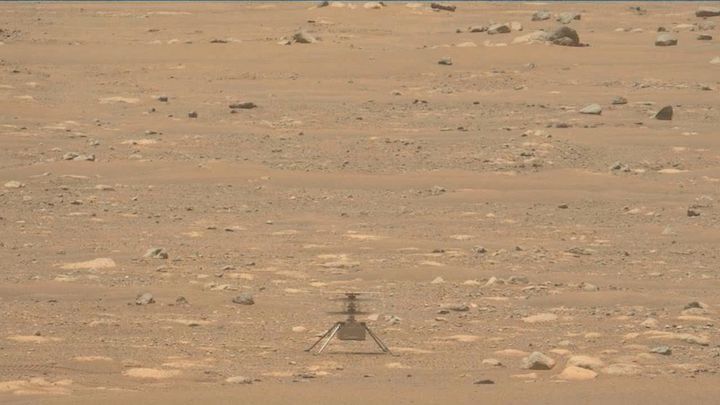
CAPE CANAVERAL, Fla. -- NASA’s little Mars helicopter has gotten a reprieve.
Instead of wrapping up flight tests at the beginning of May, NASA is giving its Ingenuity helicopter at least an extra month to tackle tough new terrain and serve as a scout for its companion rover, Perseverance.
Officials announced the flight extension Friday, following three short flights in under two weeks for the $85 million tech demo. Soon afterward, there was more good news: Ingenuity — the first powered aircraft to soar at another planet — had aced its fourth flight at Mars.
For Friday's trip, Ingenuity traveled 872 feet (266 meters) at a height of 16 feet (5 meters) for two minutes — considerably farther and longer than before. An attempt Thursday had failed because of a known software error.
On its fifth flight in another week or so, the 4-pound (1.8-kilogram) chopper will move to a new airfield on Mars, allowing the rover to finally start focusing on its own rock-sampling mission. The rover is seeking signs of ancient life at Jezero Crater, home to a lush lakebed and river delta billions of years ago.
The helicopter team at NASA's Jet Propulsion Laboratory in Pasadena, California, expects to chalk up a sixth and seventh flight in May. The previous limit had been five. If all goes well, the helicopter mission could go even longer.
“Ingenuity loves Mars,” project manager MiMi Aung told reporters. “It takes off and I almost feel the freedom that it feels."
Now Perseverance will take priority, scoping out the rocks around the Feb. 18 landing site. Ingenuity hitched a ride to Mars on the rover's belly, launching from Cape Canaveral last summer. Managers expect the rover to collect its first sample in July for return to Earth in a decade.
The rover will continue to relay data and pictures from the helicopter, but stop taking its own chopper shots. The two spacecraft must be within a half-mile (1 kilometer) of one another, for communication relay.
Designed to operate on Mars for 30 days, Ingenuity probably can survive the freezing Martian nights — and repeated flights in the extremely thin atmosphere — for at least another few months.
“We really do expect some finite life," Aung said, “and so it will be a race between how long these parts surprise us in surviving."
Quelle: abcNews

